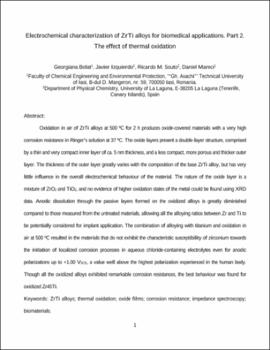Electrochemical characterization of ZrTi alloys for biomedical applications. Part 2. The effect of thermal oxidation
Fecha
2013Resumen
Oxidation in air of ZrTi alloys at 500 ºC for 2 h produces oxide-covered materials with a very high corrosion resistance in Ringer’s solution at 37 ºC. The oxide layers present a double-layer structure, comprised by a thin and very compact inner layer of ca. 5 nm thickness, and a less compact, more porous and thicker outer layer. The thickness of the outer layer greatly varies with the composition of the base ZrTi alloy, but has very little influence in the overall electrochemical behaviour of the material. The nature of the oxide layer is a mixture of ZrO2 and TiO2, and no evidence of higher oxidation states of the metal could be found using XRD data. Anodic dissolution through the passive layers formed on the oxidized alloys is greatly diminished compared to those measured from the untreated materials, allowing all the alloying ratios between Zr and Ti to be potentially considered for implant application. The combination of alloying with titanium and oxidation in air at 500 ºC resulted in the materials that do not exhibit the characteristic susceptibility of zirconium towards the initiation of localized corrosion processes in aqueous chloride-containing electrolytes even for anodic polarizations up to +1.00 VSCE, a value well above the highest polarization experienced in the human body. Though all the oxidized alloys exhibited remarkable corrosion resistances, the best behaviour was found for oxidized Zr45Ti.






